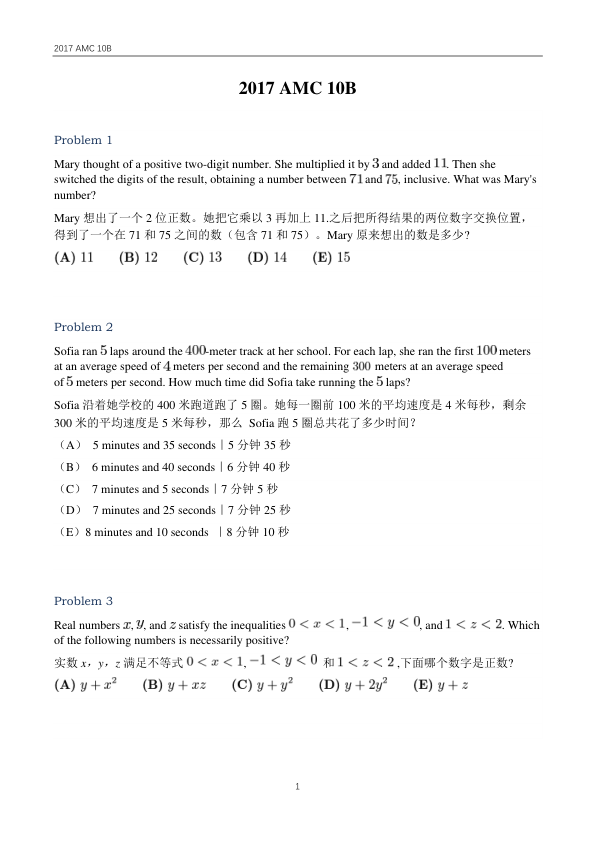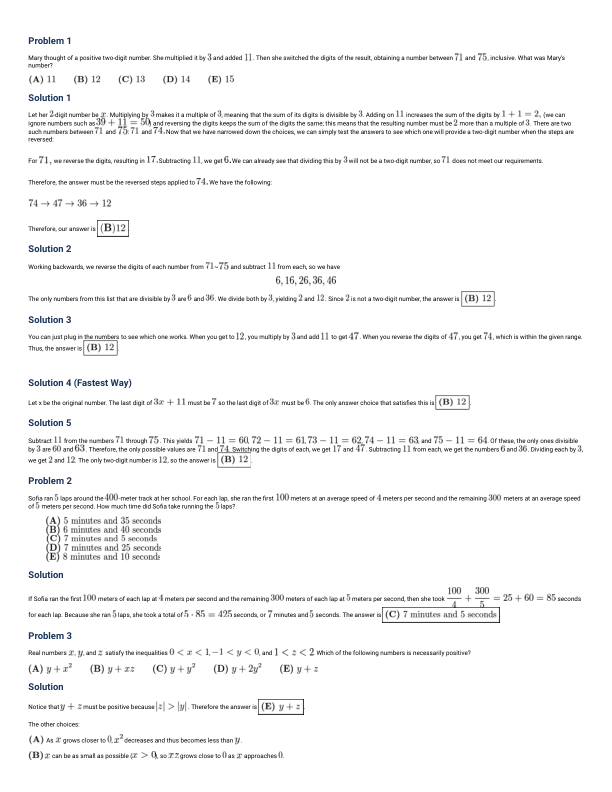2017 AMC amc10b 真题 答案 详解
| 序号 | 文件列表 | 说明 | ||
|---|---|---|---|---|
| 1 | 2017-amc10b-paper-eng-zh.pdf | 9 页 | 480.82KB | 中英双语真题 |
| 2 | 2017-amc10b-paper-eng.pdf | 3 页 | 193.03KB | 英文真题 |
| 3 | 2017-amc10b-key.pdf | 1 页 | 10.17KB | 真题答案 |
| 4 | 2017-amc10b-solution-eng.pdf | 21 页 | 1.86MB | 真题文字详解(英文) |
| 5 | 2017-amc10b-solution-eng-zh.pdf | 21 页 | 1.88MB | 真题文字详解(中英双语) |
| 6 | 2017-amc10b-solution-video-zh.mp4 | 34.06 分钟 | 100.56MB | 真题视频详解(普通话) |
中英双语真题
2017 AMC 10B
Problem 1
Mary thought of a positive two-digit number. She multiplied it by 3 and added 11. Then she switched the digits of the result, obtaining a number between 71 and 75, inclusive. What was Mary's number?
Mary 想出了一个2位正数。她把它乘以3再加上11之后把所得结果的两位数字交换位置,得到了一个在71和75之间的数(包含71和75)。Mary原来想出的数是多少?
(A) 11 (B) 12 (C) 13 (D) 14 (E) 15
Problem 2
Sofia ran 5 laps around the 400-meter track at her school. For each lap, she ran the first 100 meters at an average speed of 4 meters per second and the remaining 300 meters at an average speed of 5 meters per second. How much time did Sofia take running the 5 laps?
Sofia 沿着她学校的400米跑道跑了5圈。她每一圈前100米的平均速度是4米每秒,剩余300米的平均速度是5米每秒,那么 Sofia 跑5圈总共花了多少时间?
(A) 5 minutes and 35 seconds | 5分钟35秒 (B) 6 minutes and 40 seconds | 6分钟40秒 (C) 7 minutes and 5 seconds | 7分钟5秒 (D) 7 minutes and 25 seconds | 7分钟25秒 (E) 8 minutes and 10 seconds | 8分钟10秒
Problem 3
Real numbers x, y, and z satisfy the inequalities 0 < x < 1, -1 < y < 0, and 1 < z < 2. Which of the following numbers is necessarily positive?
实数x,y,z满足不等式0<x<1,-1<y<0和1<z<2,下面哪个数字是正数?
(A) y + x^2 (B) y + xz (C) y + y^2 (D) y + 2y^2 (E) y + z

英文真题
2017 AMC 10B Problems
Problem 1
Mary thought of a positive two-digit number. She multiplied it by $3$ and added $11$. Then she switched the digits of the result, obtaining a number between $71$ and $75$, inclusive. What was Mary's number?
[ \begin{array}{ll} \text{(A)} & 11 \ \text{(B)} & 12 \ \text{(C)} & 13 \ \text{(D)} & 14 \ \text{(E)} & 15 \ \end{array} ]
Problem 2
Sofia ran $5$ laps around the $400$-meter track at her school. For each lap, she ran the first $100$ meters at an average speed of $4$ meters per second and the remaining $300$ meters at an average speed of $5$ meters per second. How much time did Sofia take running the $5$ laps?
[ \begin{array}{ll} \text{(A)} & 5 \text{ minutes and } 35 \text{ seconds} \ \text{(B)} & 6 \text{ minutes and } 40 \text{ seconds} \ \text{(C)} & 7 \text{ minutes and } 5 \text{ seconds} \ \text{(D)} & 7 \text{ minutes and } 25 \text{ seconds} \ \text{(E)} & 8 \text{ minutes and } 10 \text{ seconds} \ \end{array} ]
Problem 3
Real numbers $x$, $y$, and $z$ satisfy the inequalities $0 < x < 1$, $-1 < y < 0$, and $1 < z < 2$. Which of the following numbers is necessarily positive?
[ \begin{array}{ll} \text{(A)} & y + x^2 \ \text{(B)} & y + xz \ \text{(C)} & y + y^2 \ \text{(D)} & y + 2y^2 \ \text{(E)} & y + z \ \end{array} ]
Problem 4
Suppose that $x$ and $y$ are nonzero real numbers such that $\frac{3x+y}{x-3y} = -2$. What is the value of $\frac{x+3y}{3x-y}$?
[ \begin{array}{ll} \text{(A)} & -3 \ \text{(B)} & -1 \ \text{(C)} & 1 \ \text{(D)} & 2 \ \text{(E)} & 3 \ \end{array} ]
Problem 5
Camilla had twice as many blueberry jelly beans as cherry jelly beans. After eating $10$ pieces of each kind, she now has three times as many blueberry jelly beans as cherry jelly beans. How many blueberry jelly beans did she originally have?
[ \begin{array}{ll} \text{(A)} & 10 \ \text{(B)} & 20 \ \text{(C)} & 30 \ \text{(D)} & 40 \ \text{(E)} & 50 \ \end{array} ]
Problem 6
What is the largest number of solid $2$ in. by $2$ in. by $1$ in. blocks that can fit in a $3$ in. by $2$ in. by $3$ in. box?
[ \begin{array}{ll} \text{(A)} & 3 \ \text{(B)} & 4 \ \text{(C)} & 5 \ \text{(D)} & 6 \ \text{(E)} & 7 \ \end{array} ]
Problem 7
Samia set off on her bicycle to visit her friend, traveling at an average speed of $17$ kilometers per hour. When she had gone half the distance to her friend's house, a tire went flat, and she walked the rest of the way at $5$ kilometers per hour. In all it took her $44$ minutes to reach her friend's house. In kilometers rounded to the nearest tenth, how far did Samia walk?
[ \begin{array}{ll} \text{(A)} & 2.0 \ \text{(B)} & 2.2 \ \text{(C)} & 2.8 \ \text{(D)} & 3.4 \ \text{(E)} & 4.4 \ \end{array} ]
Problem 8
Points $A(11,9)$ and $B(2,-3)$ are vertices of $\triangle ABC$ with $AB=AC$. The altitude from $A$ meets the opposite side at $D(-1,3)$. What are the coordinates of point

真题文字详解(英文)
Problem 1 Mary thought of a positive two-digit number. She multiplied it by 3 and added 11. Then she switched the digits of the result, obtaining a number between 71 and 75, inclusive. What was Mary's number?
(A) 11 (B) 12 (C) 13 (D) 14 (E) 15
Solution 1 Let her 2-digit number be ( x ). Multiplying by 3 makes it a multiple of 3, meaning that the sum of its digits is divisible by 3. Adding on 11 increases the sum of the digits by 1 + 1 = 2. (we can ignore numbers such as 39 + 11 = 50) and reversing the digits keeps the sum of the digits the same; this means that the resulting number must be 2 more than a multiple of 3. There are two such numbers between 71 and 75: 71 and 74. Now that we have narrowed down the choices, we can simply test the answers to see which one will provide a two-digit number when the steps are reversed: For 71, we reverse the digits, resulting in 17. Subtracting 11, we get 6. We can already see that dividing this by 3 will not be a two-digit number, so 71 does not meet our requirements. Therefore, the answer must be the reversed steps applied to 74. We have the following:
( 74 \rightarrow 47 \rightarrow 36 \rightarrow 12 )
Therefore, our answer is (B) 12.
Solution 2 Working backwards, we reverse the digits of each number from 71-75 and subtract 11 from each, so we have
( 6, 16, 26, 36, 46 )
The only numbers from this list that are divisible by 3 are 6 and 36. We divide both by 3, yielding 2 and 12. Since 2 is not a two-digit number, the answer is (B) 12.
Solution 3 You can just plug in to see which one works. When you get to 12, you multiply by 3 and add 11 to get 47. When you reverse the digits of 47, you get 74, which is within the given range. Thus, the answer is (B) 12.
Solution 4 (Fastest Way) Let ( x ) be the original number. The last digit of ( 3x + 11 ) must be 7 so the last digit of ( 3x ) must be 6. The only answer choice that satisfies this is (B) 12.
Solution 5 Subtract 11 from the numbers 71 through 75. This yields 60, 61, 62, 63, and 64. Of these, the only ones divisible by 3 are 60 and 63. Therefore, the only possible values are 71 and 74. Switching the digits of each, we get 17 and 47. Subtracting 11 from each, we get the numbers 6 and 36. Dividing each by 3, we get 2 and 12. The only two-digit number is 12, so the answer is (B) 12.
Problem 2 Sofia ran 5 laps around the 400-meter track at her school. For each lap, she ran the first 100 meters at an average speed of 4 meters per second and the remaining 300 meters at an average speed of 5 meters per second. How much time did Sofia take running the 5 laps?
(A) 5 minutes and 35 seconds
(B) 6 minutes and 40 seconds
(C) 7 minutes and 5 seconds
(D) 7 minutes and 25 seconds
(E) 8 minutes and 10 seconds
Solution If Sofia ran the first 100 meters of each lap at 4 meters per second and the remaining 300 meters of each lap at 5 meters per second, then she took ( \frac{100}{4} + \frac{300}{5} = 25 + 60 = 85 ) seconds for each lap. Because she ran 5 laps, she took a total of ( 5 \cdot 85 = 425 ) seconds, or 7 minutes and 5 seconds. The answer is (C) 7 minutes and 5 seconds.
Problem 3 Real numbers ( x, y, ) and ( z ) satisfy the inequalities ( 0 < x < 1, -1 < y < 0, ) and ( 1 < z < 2 ). Which of the following numbers is necessarily positive?
(A) ( y + x^2 )
(B) ( y + xz )
(C

真题文字详解(中英双语)
Problem 1 Mary thought of a positive two-digit number. She multiplied it by 3 and added 11. Then she switched the digits of the result, obtaining a number between 71 and 75, inclusive. What was Mary's number? Mary 想到一个正的两位数。她把它乘以 3 并加上 11。然后她交换结果的数字,得到一个在 71 和 75 之间(包括 71 和 75)的数。Mary 的数是多少? (A) 11 (B) 12 (C) 13 (D) 14 (E) 15 Solution 1 Let her 2-digit number be x. Multiplying by 3 makes it a multiple of 3, meaning that the sum of its digits is divisible by 3. Adding on 11 increases the sum of the digits by 1 + 1 = 2, (we can ignore numbers such as 39 + 11 = 50 and reversing the digits keeps the sum of the digits the same; this means that the resulting number must be 2 more than a multiple of 3. There are two such numbers between 71 and 75: 71 and 74. Now that we have narrowed down the choices, we can simply test the answers to see which one will provide a two-digit number when the steps are reversed: For 71, we reverse the digits, resulting in 17. Subtracting 11, we get 6. We can already see that dividing this by 3 will not be a two-digit number, so 71 does not meet our requirements. Therefore, the answer must be the reversed steps applied to 74. We have the following: 74 → 47 → 36 → 12 Therefore, our answer is (B) 12 Solution 2 Working backwards, we reverse the digits of each number from 71-75 and subtract 11 from each, so we have 6, 16, 26, 36, 46 The only numbers from this list that are divisible by 3 are 6 and 36. We divide both by 3, yielding 2 and 12. Since 2 is not a two-digit number, the answer is (B) 12 Solution 3 You can just plug in the numbers to see which one works. When you get to 12, you multiply by 3 and add 11 to get 47. When you reverse the digits of 47, you get 74, which is within the given range. Thus, the answer is (B) 12 Solution 4 (Fastest Way) Let x be the original number. The last digit of 3x + 11 must be 7 so the last digit of 3x must be 6. The only answer choice that satisfies this is (B) 12 Solution 5 Subtract 11 from the numbers 71 through 75. This yields 71 - 11 = 60, 72 - 11 = 61, 73 - 11 = 62, 74 - 11 = 63, and 75 - 11 = 64. Of these, the only ones divisible by 3 are 60 and 63. Therefore, the only possible values are 71 and 74. Switching the digits of each, we get 17 and 47. Subtracting 11 from each, we get the numbers 6 and 36. Dividing each by 3, we get 2 and 12. The only two-digit number is 12, so the answer is (B) 12 Problem 2 Sofia ran 5 laps around the 400-meter track at her school. For each lap, she ran the first 100 meters at an average speed of 4 meters per second and the remaining 300 meters at an average speed of 5 meters per second. How much time did Sofia take running the 5 laps? (A) 5 minutes and 35 seconds (B) 6 minutes and 40 seconds (C) 7 minutes and 5 seconds (D) 7 minutes and 25 seconds (E) 8 minutes and 10 seconds Solution If Sofia ran the first 100 meters of each lap at 4 meters per second and the remaining 300 meters of each lap at 5 meters per second, then she took 100/4 + 300/5 = 25 + 60 = 85 seconds for each lap. Because she ran 5 laps, she took a total of 5 · 85 = 425 seconds, or 7 minutes and 5 seconds. The answer is (C) 7 minutes and 5 seconds Problem 3 Real numbers x, y, and z satisfy the inequalities 0 < x < 1, -1 < y < 0, and 1 < z < 2 Which of the following numbers is necessarily positive? (A) y + x^2

